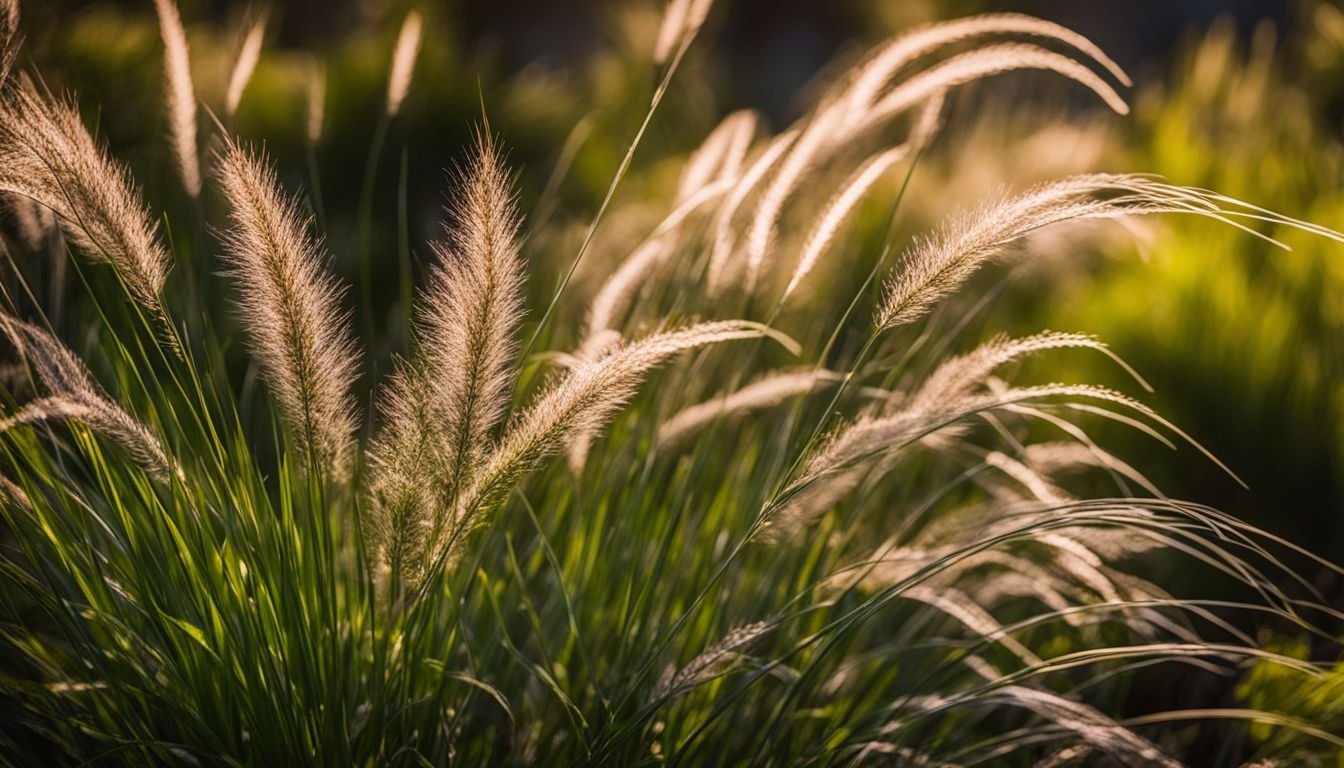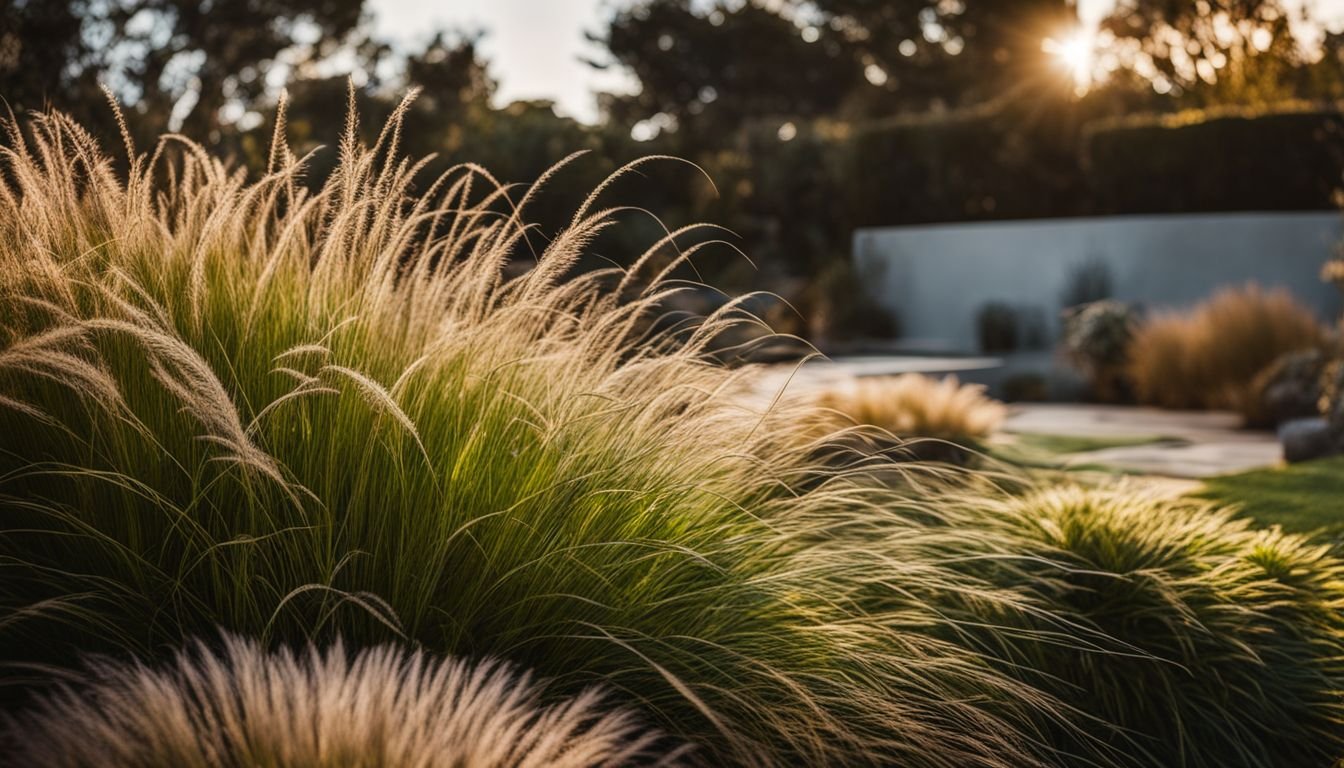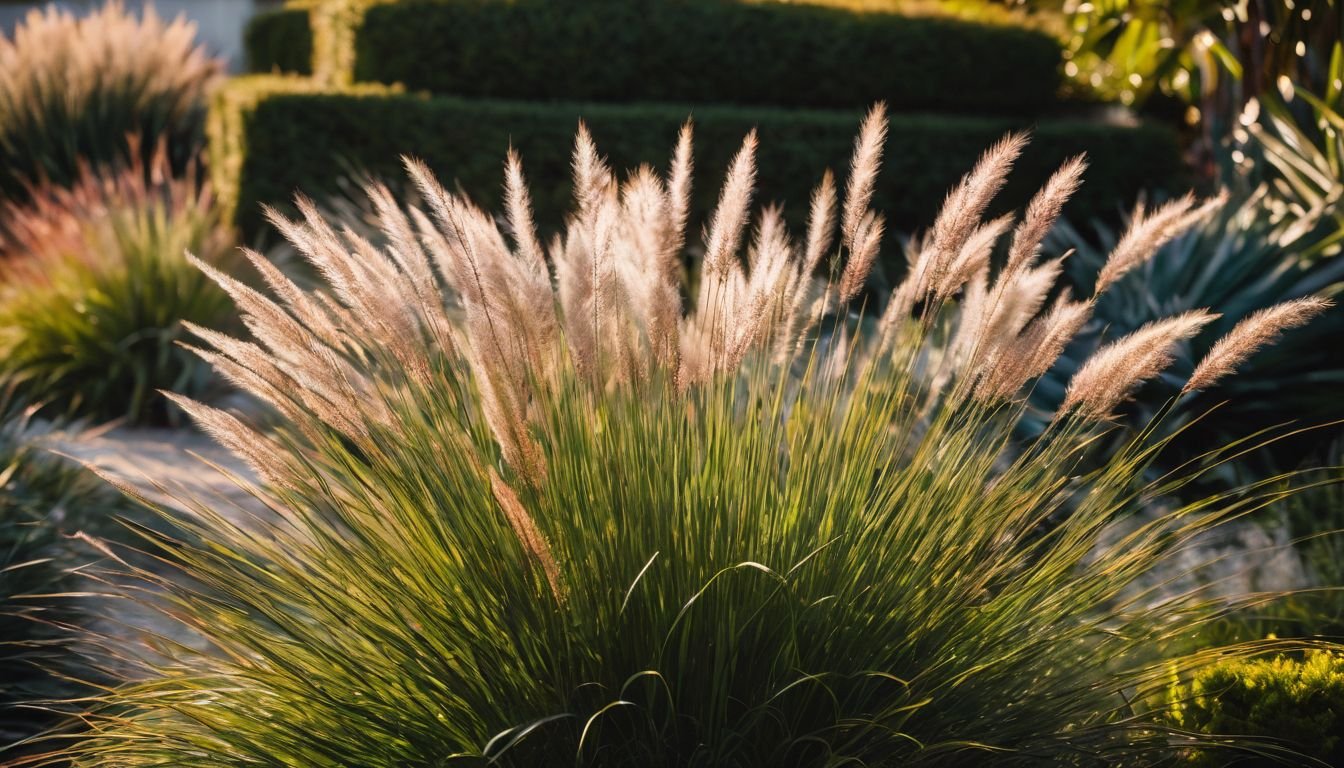Gardening down under is a bit like playing the weather lottery – you never quite know what you’re going to get. With our summers that can sizzle your sandals off and winters that’ll have you reaching for an extra jumper, it’s no small task keeping a garden looking good without tending to it every spare minute.
Enter Dwarf Fountain Grass, or as I like to call it, the garden’s little legend. In the world of ornamental grasses, this sturdy and compact variety really does take the cake for fitting into Aussie gardens like a dream.
It doesn’t just cope with our wild weather swings; it flourishes, bringing its dark burgundy-red leaves and those stylish creamy-pink foxtail plumes into the mix. They’re not just pretty; they’re practically shouting “Struth! Look at me!” And honestly? We reckon they’ve earned bragging rights.
Our squad has been out in the trenches (or should we say flower beds?), combining research with hands-on dirt time to make sure this guide on Dwarf Fountain Grass turns your patch of green from ‘just surviving’ to absolutely thriving.
So if you’re keen as mustard on giving your garden a makeover without signing away all your free time, stick around. We’ve got all the nitty-gritty details from planting right through to care tips that’ll have your Dwarf Fountain Grass basking in glory – and possibly even making your neighbours a tad envious.
Let’s get stuck into it!
Key Takeaways
- Dwarf Fountain Grass, known as Pennisetum alopecuroides, is perfect for the Australian climate because it can grow well under full sun or part shade. This makes it a versatile choice for different parts of your garden.
- It’s a low – maintenance plant that becomes even easier to care for once established. Just give it regular watering and some mulch early on, then enjoy its beauty with minimal effort afterwards.
- This ornamental grass comes in several varieties like Hameln, Burgundy Bunny, Little Bunny, Red Head, and Moudry. Each variety has unique features but all share the same resilience and ease of care.
- Planting Dwarf Fountain Grass offers benefits like erosion control and drought tolerance, making it an eco-friendly option for gardens. Plus, its lush foliage and foxtail plumes add stunning visual appeal year-round.
- To get the best out of your Dwarf Fountain Grass: choose sunny or partly shaded spots in your garden; make sure the soil drains well; mulch around its base; water regularly until established; cut back in late winter to encourage fresh growth.
Overview of Dwarf Fountain Grass

Dwarf Fountain Grass, known scientifically as Pennisetum alopecuroides, thrives in the Australian climate, from full sun to part shade. This ornamental grass offers a compact growth habit and unique visual appeal for any garden setting.
Description and characteristics
Dwarf Fountain Grass stands out as a hardy, compact gem in our gardens. It sports burgundy-red foliage that strikes a vivid contrast against the creamy-pink fluffy foxtail plumes. Growing to 0.5 meters in height and 0.3 meters in width, this ornamental grass finds its perfect spot in rockeries, borders, and even containers.
Its ability to thrive under full sun to part shade makes it a versatile choice for gardeners.
We find that well-drained soil suits Dwarf Fountain Grass best, yet it surprises us with its robustness across various soil conditions. The plant’s fast growth rate alongside its tolerance for humidity, high temperatures, and wind contributes to its reputation as low maintenance and drought tolerant.
For those seeking an attractive solution for erosion control or mass planting without hassle, this grass proves itself time and again as an excellent option.
Our experiences tell us mulching plays a critical role during initial growth stages by conserving moisture and regulating soil temperature around the roots of Dwarf Fountain Grass.
Regular watering until establishment ensures thriving health but once settled; they require minimal attention despite seasonal changes or borderline climates late into autumn. This resilience places Dwarf Fountain Grass among Australia’s favoured ornamental additions – both for aesthetic appeal and practical gardening benefits.
Varieties of Dwarf Fountain Grass
We often find ourselves searching for the perfect addition to our gardens, and we’re thrilled to share that Dwarf Fountain Grass offers several stunning varieties to suit diverse Australian landscapes. From its deep burgundy-red foliage to creamy-pink fluffy foxtail plumes, this member of the Poaceae family is an excellent choice for anyone looking to add texture and colour to their space.
- Hameln: This variety is famous for its compact size and soft, green summer foliage that transitions into a golden hue in autumn. Its fluffy, wheat-coloured plumes make it a standout in any garden setting.
- Burgundy Bunny: True to its name, this variety flaunts warm burgundy leaves throughout the warmer months before turning a fiery red in autumn. It’s particularly striking in rockeries or as an accent plant.
- Little Bunny: The smallest of the bunch, Little Bunny is perfect for containers or small spaces. Despite its size, it packs a visual punch with abundant fluffy seed heads that wave gracefully in the breeze.
- Red Head: It earns its name from the spectacular smoky-purple foxtail plumes that appear in summer and last well into autumn. Its foliage starts green but takes on beautiful orange tones as cooler weather sets in.
- Moudry: Known for its glossy black seed heads, Moudry offers a unique visual contrast against its green foliage which turns golden yellow in fall, making it a dramatic backdrop or focal point.
Benefits of Growing Dwarf Fountain Grass

We all cherish a garden that flourishes with minimal fuss, and growing Dwarf Fountain Grass offers just that. It thrives in our tough Australian climates, proving to be a resilient choice for both seasoned and amateur gardeners alike.
Low maintenance
Dwarf fountain grass becomes a gardener’s dream once it has settled into its new home. Initially, it does ask for regular watering and a bit of mulch to keep its roots happy. However, this phase doesn’t last long.
Before you know it, this member of the grasses family switches gears into low maintenance mode. This means less time with the hose and more time enjoying your garden’s beauty.
Cutting back the plant in late winter prepares it for a burst of fresh growth come spring. This simple step ensures your dwarf fountain grass remains vibrant and full-bodied throughout the year.
Forget about complicated care routines or frequent trips to the post office for gardening supplies. Embrace this easy-care ornamental that thrives with minimal fuss, letting you focus on other hobbies or perhaps even enjoy some extra leisure time exploring online payment options for your next set of garden enhancements through internet banking – all while respecting privacy policies, of course!
Hardy and drought tolerant
We know the struggle of keeping a garden lush and vibrant during those relentless Aussie summers. That’s where Dwarf Fountain Grass comes into its own as a hero plant for dry conditions.
This resilient grass thrives in our tough climate, showing off its beautiful foliage even when the mercury soars and rain is but a memory. It stands up well to high temperatures, wind, and even humidity, making it an ideal choice for gardeners seeking beauty without the constant worry about water.
Purple fountain grass and swamp foxtail grass are often praised for their visual appeal but require more moisture to maintain their attractiveness. On the other hand, Dwarf Fountain Grass asks for far less yet delivers striking greenery and movement in your garden space.
Once established over approximately 12 weeks with regular watering, this steadfast plant shifts into cruise control, demanding very little from you while continuing to flourish. Even better, mulching in late autumn helps protect its roots in cooler climates, further reducing any gardener’s workload.
Caring for this ornamental gem becomes almost effortless after its establishment phase. Its adaptation to most soil conditions means you won’t find yourself constantly testing or amending your garden soil to meet some finicky requirements.
Instead, you get to sit back and enjoy the swaying of this hardy grass that adds texture and depth to your landscape design with minimal fuss.
How to Grow and Care for Dwarf Fountain Grass
Growing Dwarf Fountain Grass in our Australian gardens adds a touch of whimsy and ease. This hardy, compact ornamental grass brings life to rockeries, borders, and even containers with minimal effort.
- Choose a sunny to partly shaded spot in your garden. Dwarf Fountain Grass thrives under full sun but can also tolerate part shade, making it versatile for various garden layouts.
- Prepare the soil well by ensuring it is well – drained. While this plant can adapt to most soil conditions, starting with a good foundation helps it establish quicker.
- Mulch around the base after planting. This step keeps the moisture in and helps protect the roots during those critical first 12 weeks and again in late autumn for areas with borderline climates.
- Water regularly until your Dwarf Fountain Grass is established. Initially giving it enough water helps it settle into its new home without stress.
- Cut back the plant in late winter. Doing so encourages fresh new growth come spring, keeping your grass looking vibrant and healthy.
- Enjoy its low maintenance nature once established. After the initial care phase, you’ll find Dwarf Fountain Grass doesn’t ask much from us but gives back so much more in terms of beauty and resilience.
Discover More About Plants
After mastering the essentials of nurturing Dwarf Fountain Grass, let’s delve deeper and widen our botanical horizons. Exploring a variety of plants enriches our gardening experiences and diversifies our outdoor spaces.
Australia’s unique climate offers the perfect backdrop for an array of ornamental grasses and plants that bring texture, colour, and life to gardens. Each plant comes with its own story, habitat preferences, and care needs that fascinate those of us who cherish greenery.
Venturing further into the world of horticulture introduces us to companions for our Dwarf Fountain Grass like Festuca Glauca or Cordyline Australis Red Sensation. These species share similar attributes such as drought tolerance and stunning visuals but also introduce new elements to the garden with their varied foliage colours and growth habits.
Learning about these alternatives equips us with more options for creating dynamic landscapes tailored to specific looks or environmental conditions.
Diving into plant research not only broadens our knowledge but also prepares us for greater gardening success. We discover which plants thrive together based on their water, soil, and sunlight requirements.
This synergy between different species leads to healthier gardens that are easier to maintain while delivering aesthetically pleasing results year-round. Furthermore, understanding the dimensions a fully grown plant reaches helps in planning space allocation efficiently so each plant can flourish without competition for resources.
Conclusion
Dwarf Fountain Grass proves itself as a splendid choice for Aussie garden lovers. Its hardy nature and compact form offer both beauty and resilience to any outdoor space. With minimal care, it thrives, bringing dark burgundy-red foliage and creamy-pink plumes that captivate the eye.
Embracing this plant means enjoying a lush, low-maintenance garden year-round. Let’s make our gardens vibrant with Dwarf Fountain Grass, celebrating its grace in every season.
FAQs
1. Can Dwarf Fountain Grass survive in hot Australian climates?
Yes, Dwarf Fountain Grass thrives in hot Australian climates due to its hardy nature.
2. Do I need to water Dwarf Fountain Grass often?
Dwarf Fountain Grass requires minimal watering once established, making it perfect for low-water gardens.
3. Will Dwarf Fountain Grass attract wildlife to my garden?
Yes, the grass attracts birds and butterflies, adding life and movement to your garden.
4. How tall does Dwarf Fountain Grass grow?
Dwarf Fountain Grass typically grows up to 90 centimeters tall, ideal for compact spaces or as a garden border.
5. Is Dwarf Fountain Grass easy to maintain?
Yes, this plant is low-maintenance, needing only occasional trimming to keep it looking tidy.
